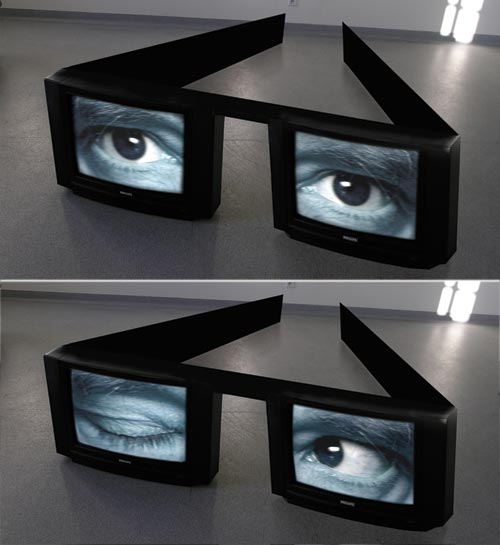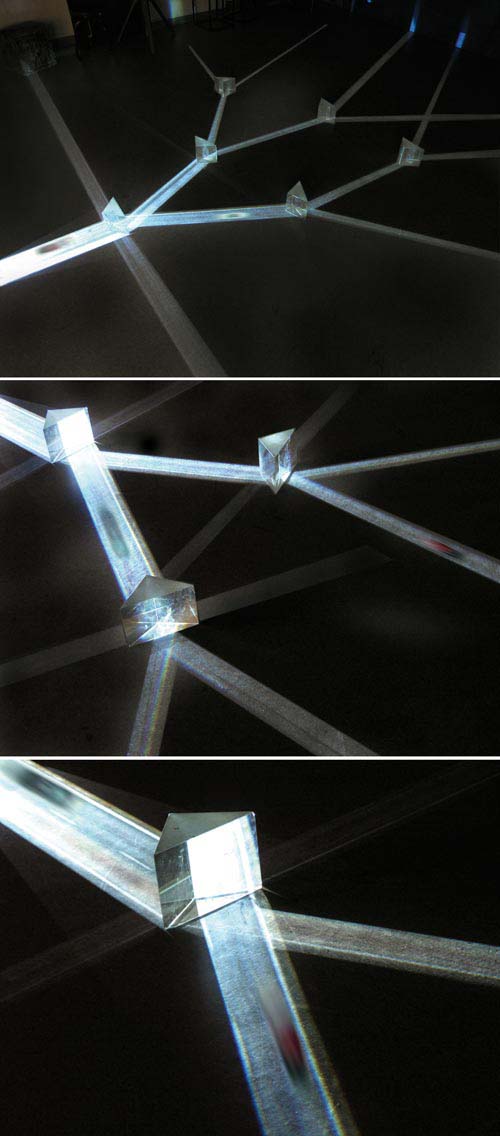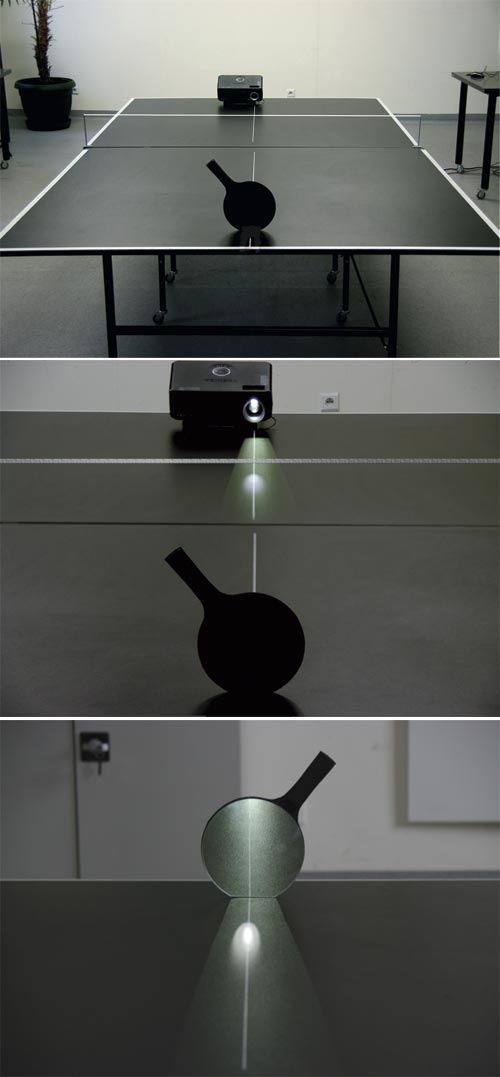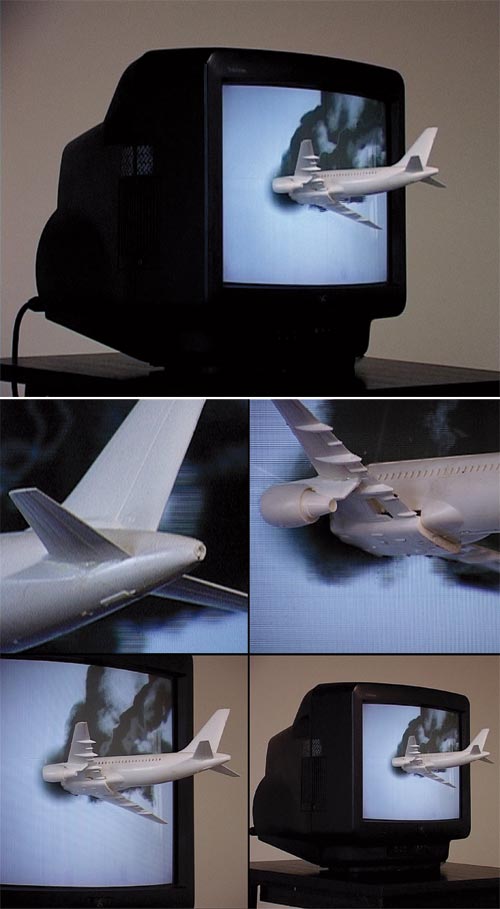

video-installation, two photo-frames, recording of video, 2006

Videoway
video-installation, board-screen 250cm x 300cm, 5 glass prism, multimedia projector, video, 2001
From ages past we know numerous examples of art that used to entertain and educate the viewers by means of illusion. There are accounts preserved from antiquity that tell us of the achievements of painters whose pictures were such perfect imitations of reality that they could fool humans and even animals. Beginning in the 15th century the art of perspective and its illusion came into being, mainly in painting connected with architecture and stage design. Between 18th and 19th century panoramas and dioramas appeared - performances based on the art of painting ensured better reception and better understanding of the stage set. Painted canvas was used along with real objects and their imitations in the foreground, so the viewer's eye could not find the line dividing the real and only apparently three-dimensional objects (as in the Panorama of Racławice). Optical illusions in the old days were also produced by means of various uses of camera obscura. All variants of such illusory presentations had - from the point of view of today - a certain common feature: in the confrontation of the category of reality and artificiality the authority of illusion dominated. Illusion was something mysterious and difficult to achieve and came closer to the spiritual sphere, contrary to the material world which was not valued as highly.
This situation changed in the age of the industrial revolution when photography appeared, and then along with it other new techniques based on the automatic registration of images. Because the photographic picture was considered to be a direct reflection of reality, it was identified with concrete and made photography an instrument of the rational interpretation of the world. Moreover, photography as a visual document became the point of reference for all methods of producing images in art. Therefore - contrary to the previous epoch - the authority of the concrete begins to dominate in the relations between a concrete object (matter) and its visual imitation. The rule of illusionism which embraces abstract ideals becomes subordinated to the prestige of facts.
Beginning in the middle of the 19th century, artists considering their strategies were looking for a compromise between the demands of scientific, empirical verification and artistic idealization. In photography such a strategy basically came down to making the viewer realize the differences between the photographic image of reality and photography as such. Initially the proposition of photographic pictorialism was put forward, a tendency in which discrete capabilities of the photographic process were stressed by pointing to its relations with the painting tradition. However, avant-garde art of the 20th century noticed a larger cognitive potential in the ambiguous treatment of the photographic illusion. In this concept of art the image could function both as a concrete and an illusion, though this unsettling ambiguity was stressed. Such a combination of oppositions can be seen, for example, in the rules of the avant-garde photo-montage, and this feature was frequently employed by surrealists in their photography, films, collages and paintings. In their programme, concrete and illusory objects were given equal status, like external and internal manifestations of various emotions and experiences. A diiferent attitude was adopted by Marcel Duchamp who in his "ready mades" rejected illusion completely, replacing it with concrete objects which on the other hand made the notion of art radically abstract. Later conceptualists adopted the strategy of questioning the purpose and target of art in a slightly different way, more often than not focusing on unmasking of the techniques of "deception" in the process of social communication of art. However, they described these procedures by means of photography, films and video registrations which always combined the attributes and values of both document and fiction. The so-called "photomedia art" of the 1960s and 1970s, the tendency which included the analysis of the instruments and language of art, as well as the criticism of various ways in which mass media function, revealed them to be vehicles of political and commercial manipulation.
We could argue that every stage of industrial revolution had its own version of the reflection on the role of the media, dependent on the current level of the development of mass culture. The early avant-garde, for example, was associated with amateur photography, the illustrated press and the origins of the cinema. On the other hand, after World War II the popularity of television and easy access to various technical goods, including photographic cameras, became an important feature. At that time the premises of media analyses became more easily understood by the average citizen, while progressive artists noticed the necessity to make those problems a part of their practice. A good example here is an artist from Wrocław, Zdzisław Jurkiewicz, who gave up painting for some time and produced two photographic works in 1970. His Incident consisted of a series of photographs of the model of a plane, hanging in the window on a nylon string. When the camera was positioned correctly, the sun reflected in the window-pane suggested that the "plane" exploded, while other pictures of the same model revealed that this image was just a trick, a "fraud". The second of those works by Jurkiewicz, called On the Wall, Canvas and Easel, is a series of photographs in which a large rectangular frame appears within the space of the author's workshop. It seems to actually exist there as an object, but the author - who moves within the field of the camera's vision - reveals the trick, performed by placing a small black frame in front of the camera lens (I recall those works because they are analogous with certain contemporary works by Ryszard Jędroś). In the 1970s such ostentatious manipulations performed on documents were often used, among others, by artists from the circles of the Łódź Film Form Workshop in their photographic, film and video installation works (Józef Robakowski, Andrzej Różycki, Wojciech Bruszewski, Zygmunt Rytka and others). Those works were a part of the international postconceptual tendency in art, opening onto media culture and introducing elements of critical reflection.
This situation began to change significantly once again in the 1980s when postmodern interpretations of culture gained a dominating position and gradually - in the 1990s - computers, digital methods of registering images and the Internet became widespread and generally accessible. At first these new possibilities were interpreted similarly to the technical achievements of the modernist period. Apparently they became instruments of broadening man's technical potential and were supposed to lessen the pressure of the traditional rigours necessary for our society to function. Nevertheless, it turned out that new electronic media cause wider and not always expected changes in human consciousness. Bearing this fact in mind, such theoreticians as Vilem Flusser proposed a strategy of resistance, modelled on photomedia art, which was supposed to rely on exposing programmes of behaviour, automatically imposed upon man by modern technology. However, how can such a strategy of resistance be effective and satisfactory today? For a man submerged in the new environment of the media the categories of reality and ilusion are so relative and mixed up that he is unable to juxtapose them in the same way as it was done before. The truth is that other fashionable contemporary categories are also naturalness and ecology, but actually the difference between the natural and the artificial has been erased. Contemporary man realizes that the influence of the real and the virtual world on his behaviour often has equally grave consequences which can be observed in such disciplines as information, medicine, the world of finances or in the military.
In this situation the juxtaposition of the notion of reality and illusion becomes less significant while the nuances of their interpenetration seem to gain more importance. Ryszard Jedroś's installation called Plane (2001) is a comment on the terrorist attack on World Trade Center of September 11th, when two hijacked planes hit the twin towers in New York City. In this work the artist glued a part of the model of a plane onto the television screen on which the image of a burning building appeared. Contrary to Zdzisław Jurkiewicz's Incident we have to do here with the registration of a real event and what is "exposed" is not actually the manipulation performed by the author but rather the exploitation of the recording of this tragedy by the media in order to make use of it according to the requirements of the current political situation. Some other works by Ryszard Jędroś can be compared with On the Wall, Canvas and Easel by Jurkiewicz. The latter began with the simulation of the existence of a certain form in space and then he exposed this illusion by dividing its shape in two with his own body. Ryszard Jędroś, on the other hand, in his work entitled Projection (2004) uses a screen made of a round plate on which a film is projected, showing the close-up of a turning spool of traditional film tape. This projection is in turn registered by another camera which also shows the space around the screen where at some point the artist himself can be seen strolling about. Actually the author does not expose anything here since we know from the very beginning that we are looking at the effects of the film projection onto the screen, so the author merely emphasizes the succession of different technical stages of the project and then the sequence in which the images were registered. A similar work by Ryszard Jędroś is Hommage ? Vittorio de Sica (2006). In this case the screens have been made of plywood wheels mounted on a real bicycle and the film of turning bicycle wheels has been projected onto them. The point of reference here is obviously the movie called Bicycle Thieves, one of the masterpieces of Italian neorealism. In this instance the "theft" of the wheels has been compensated by the new wheels or "drive" which in one sense is illusory but in another may be considered real.
In yet other works by Ryszard Jędroś we can find different variants of visual definitions of reality. For example: a virtual moth thrashing about between two burning candles, one real, one projected on the screen; a modified geometrical shape seen partly on the screen and partly beyond it; or a ping-pong ball seemingly bouncing on the table thanks to a projection of a film onto a table tennis racket provided with a mirror - these works can make us believe that we often decide what is real depending on whether we read certain messages in a symbolic or in a literal way, while our symbolic or literal attitude towards them can change constantly. In a film called Videoway (2001) Jędroś first registered the image of cars driving on the road and then projected the film through a set of opticalprisms and recorded the effect again. The stream of light projections bifurcating in prisms resembles a complex web of highways full of speeding cars. Two tenets are at play here: one includes the traffic regulations, according to which the initially filmed vehicles were moving, and the other consists of the rules of the propagation and refraction of light waves. Their combination on the one hand creates an absurd effect, but on the other it is an absolutely rational model of certain situations than can be seen as much more universal. Equally many interpretative possibilities may be found in Jedroś's installation called Videoglasses (2006) which resembles a large model of a pair of eyeglasses. The role of the lenses here is played by two monitors on whose screens we can watch films made of the movements of the human eye. However, we do not have to do with a pair of eyes but rather with two independent pictures; this creates a schizophrenic effect, contrary to natural expectations we usually might have in such a situation, which seems to point to the schizophrenic nature of the image of reality offered by the media. Technical instruments provide us with additional means of perception but the possibility of coordinating such perceptions and of their sensible use is limited. This kind of image combination undoubtedly also poses a question about the identity of the perceiving subject.
One of the most recent works by Ryszard Jędroś is an installation in which a film of a few birds is projected onto a kind of screen made of thin bars that resemble a cage. A signal - which is a recording of sounds emitted by a concrete kind of bird - causes the image of the given bird to be projected onto the cage. This work seems to be a certain exception in the art of Ryszard Jędroś as far as the interdependence of sound and image is concerned. In his previous works the sound background of his installations and projections was not based on close coordination of movement and sound and was imitational only to a small degree. Although the material for his soundtracks was produced in real circumstances which the installations recalled (like a fragment of the soundtrack from The Bicycle Thieves), it was usually so distorted that it rather resembled a kind of white noise. This kind of separation of pictures and sounds helps to turn the attention of the viewer away from documentary relations towards the perception of some more abstract features of this work. We should point out here that Ryszard Jędroś, when he was still a student at the National Higher School of Plastic Arts in Wrocław, became much indebted to Professor Leszek Kaćma who founded and managed the Department of Visual Knowledge in this school. Kaćma analyzed visual structures based on traditional painting and graphic forms, although in the 1970s some of his assistants (like Andrzej Lachowicz) included photography and film in their investigations. It seems that thanks to those influences Ryszard Jędroś - who uses a different technique altogether - is still an artist who remains quite sensitive as far as classical methods of visualization go. This helps him to remain consistent and finely tuned to the world in which the new media allow us to manipulate others very easily - and consequently to erase both differences and meanings.
Adam Sobota

Cage
insatallation, cage-screen, multimedia projector, computer animations, 2009

Fireplace
video-installation, TV screen 29", wideo, developmet reminiscent real firepalce, 2008

Ping-pong
multimedia installation, multimedia projector, ping-pong table, ping-pong racket with a mirror, computer animations, 2009

Plane
viedo-installation, TV screen 14", real plane toy, video, 2004
Następna wystawa
8-29 V 2010
Copyright ©2010 Galeria FF ŁDK, Ryszar Jendros, Adam Sobota